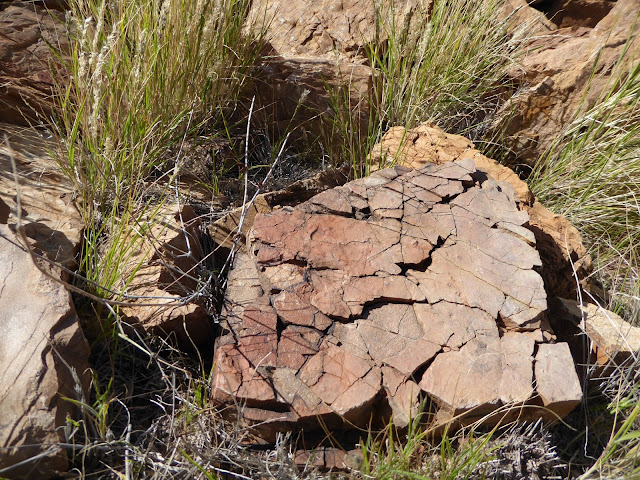July 23rd -408km
The 20 or so campsites at Coward Springs were amazingly quiet and we had enjoyed a good refreshing sleep. The early risers padded past us quietly for their morning spa soak. What a well behaved bunch!
We packed up and headed up the road. We stopped in at the old Beresford siding. Here there is also a massive dam (relic of the old railway) and ample space for sheltered camping beside the dam, or near the old railway building remains.
A short way on, we again took the side track, this time in to Strangways ruins. Here there are many ruins of buildings from what must have been a significant township. There was a series of springs, which guaranteed water. Three walks have been planned for visitors, and we took a brochure from the box and enjoyed a self guided walk around the buildings, the springs and the sad, remote cemetery area. One spring even flows over a ridge as a waterfall! (well, now it just trickles, but it used to give a good shower apparently) .
 |
| Mound spring |
Not long after this we noticed a change in the sand hills -the colour was now a pale pink/orange. The surface of the ground started to become more the red/ brown polished gibber rocks too on the higher points. These very hard rocks get gradually sandblasted and become rounded and very shiny, giving a sheen to the ground in the sunlight.
Since we were having a day of side trips we also decided to take a drive in to The Peake historical site. This was once a telegraph repeater station, mining area and had a whole little township including the "Hammer and Gad" eating house. The Telegraph station itself was a very large L shaped building . You can still look out of the old doorways and window holes towards the impressive stonework in the gully nearby (part of the mine infrastructure). This historical area has been recently fenced. You can see where campers would have once been able to camp by the nearby creek, but now this is not possible. Cross it off of your list of possible camping spots. The drive in to the Peake is via a 4WD track which is quite varied. It passes through the red gibberish desert county, pale sandy country with red rocky stone outcrops, and wide pale rocky river beds. The vegetation was amazing, with many different flowering plants. Red docks line the track in places, along with a purple flowering plant, and many white and yellows of varying shapes and sizes. The plant book was getting good use. The drive in took the best part of an hour. With the detour itself costing us about 2 hours (including lunch stop)
Algebuckina Bridge loomed soon after, with its huge imposing rusty iron structure rising out of the landscape ahead of us. Some very large caravans were parked under and near the bridge, but that didn't stop us climbing up to enjoy the view from the top. What an incredible thing it must have been to take the train over this with a raging torrent below. Today the water was quietly sitting, offering home to varied birds, and providing a tranquil stop for the holidaymakers. The local road gang had also set up their home on the other side of the road (nearer to the waterhole) and were busy improving the road from here on up for quite a few km.
We turned off towards the Painted Desert just before Oodnadatta. Now the miles of plains are mostly red gibber rocks, but sprinkled with the bright green foliage and flowers of the small plants celebrating the recent brief over abundance of water. The contrast against the red is outstanding. The plains are broken by the scattered trees in the creek beds as we pass. We were aiming to camp along one of these creeks, but again the rules have changed. A sign clearly let's us know that no camping is allowed. We need to camp at Arckaringa Homestead! (not our preferred plan). We stopped to see the painted desert as we passed, with the many mounds of varied hues protruding from the flat areas around. Ochre, white, pinks, browns, and mustards mix in an unusual display. At one viewing spot a young lady was sitting painting the view before her. She didn't seem to notice when Trevor picked a cache out from behind a tree and signed the log book.
At one stage we came across a young lad driving a small bunch of brown and white calves with their mums. A little later we could see a small helicopter up above the nearby trees in the creek, mustering the cattle, and later we came across a larger group along the road. It must be time to bring them in and do what needs to be done.
We finally arrived at Arckaringa homestead to find that a space on a bare patch of rocky ground would cost us $20! There was no-one at home, so we went out to find some firewood (as per insteuctions) in the nearby creek and brought it back to make ourselves a fire. The diesel motor was running noisily, but the sign said it would go off at night time. We enjoyed our fire , baptised the new blue billy on the campfire had tea and headed for bed. Still no-one had returned and still the noisy diesel was running. At 1200 we gave up the attempt, packed up the swags, and drove out a further 20 or so km along the road. We drove in and up a creek and reset our swags on flattish ground. There we enjoyed the beautiful silence of the outback until we fell peacefully off to sleep.










No comments:
Post a Comment